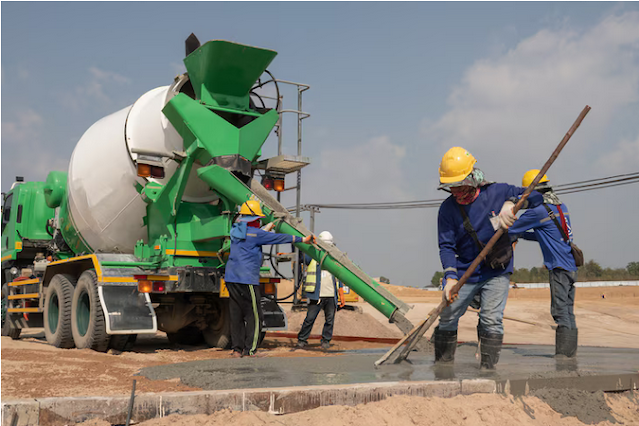Readymix Revolution: Transforming Construction with Concrete Innovation
Introduction
In the ever-evolving landscape of construction, the advent of readymix concrete has sparked a transformative revolution. This construction material, pre-mixed at centralized plants, has redefined the way structures are built. This article explores the facets of the readymix revolution, delving into the innovative approaches that have reshaped the construction industry.
The Birth of Readymix Concrete
Origins and Evolution: Readymix concrete, as we know it today, emerged in the early 20th century. Initially, concrete was mixed on-site, a process demanding significant labor and time. The concept of centralized batching plants, where concrete could be prepared in advance and transported to construction sites, marked a revolutionary shift. This innovation addressed challenges associated with on-site mixing, laying the groundwork for the readymix revolution.
Technological Advancements: Over the decades, technological advancements have propelled the readymix revolution forward. Automated batching systems, precise mix designs, and innovations in transportation methods have elevated the efficiency and quality of readymix concrete. These technological strides have not only improved construction timelines but have also contributed to the durability and strength of structures.
Advantages of Readymix Concrete
Consistency and Quality: One of the cornerstones of the readymix revolution is the consistency and quality assurance it brings to construction. The precise control over mix proportions at centralized plants ensures uniformity, minimizing variations that can arise with on-site mixing. This consistency translates to enhanced structural integrity and durability.
Time Efficiency: Readymix concrete significantly accelerates construction timelines. The elimination of on-site mixing reduces labor requirements, and the ability to transport concrete to the point of use with specialized vehicles expedites the construction process. This time efficiency is particularly crucial in today's fast-paced construction environment.
Cost Savings: While there is an initial investment in setting up readymix plants, the overall cost savings are substantial. Reduced labor costs, minimized material waste, and efficient use of resources contribute to a cost-effective solution for construction projects. The economic advantages of readymix concrete have further fueled its widespread adoption.
Innovations in Mix Design
Specialized Mixes for Diverse Applications: The readymix revolution has ushered in an era of customized mix designs. Construction projects have diverse requirements, and readymix concrete can be tailored to meet specific needs. Whether it's high-strength concrete for structural elements or self-compacting concrete for intricate forms, the flexibility in mix design is a testament to the adaptability of readymix technology.
Incorporating Additives and Admixtures: The versatility of readymix concrete extends to the incorporation of additives and admixtures. These materials, added during the mixing process, impart specific properties to the concrete. Innovations in admixtures have led to advancements such as enhanced workability, reduced permeability, and accelerated setting times, providing construction professionals with a range of options to meet project demands.
Sustainability in the Readymix Revolution
Reduced Environmental Impact: The readymix revolution aligns with sustainability goals in the construction industry. Centralized batching reduces the environmental impact associated with on-site mixing, including dust emissions and water usage. Additionally, efficient transportation methods and optimized mix designs contribute to minimizing the overall carbon footprint of construction projects.
Recycling and Waste Reduction: Sustainable practices in readymix concrete extend to the recycling of materials. Reclaimed aggregates from demolished structures can be incorporated into new mixes, reducing the demand for virgin materials. Waste reduction strategies are integral to the readymix revolution, promoting responsible resource management in construction.
Challenges and Future Directions
Logistical Challenges: Despite its numerous advantages, the readymix revolution is not without challenges. Logistical considerations, including transportation and scheduling, can pose hurdles. Innovations in logistics, such as real-time tracking and optimized route planning, are essential for addressing these challenges and further enhancing the efficiency of readymix delivery.
Continuous Innovation: The readymix revolution is an ongoing process of evolution and innovation. Continuous research and development in mix designs, incorporating new materials, and refining production processes are crucial for staying at the forefront of construction technology. The industry's commitment to innovation will shape the future trajectory of the readymix revolution.
Conclusion
The readymix revolution stands as a testament to the transformative power of innovation in the construction industry. From its origins in centralized batching to the current era of customized mix designs and sustainable practices, readymix concrete has reshaped the way structures are conceived and built.
As the construction landscape continues to evolve, the readymix revolution will play a pivotal role in meeting the demands of efficiency, sustainability, and quality. The ongoing commitment to technological advancements and the adaptation of new practices will ensure that readymix concrete remains at the forefront of construction, contributing to the creation of resilient and sustainable built environments.




Comments
Post a Comment